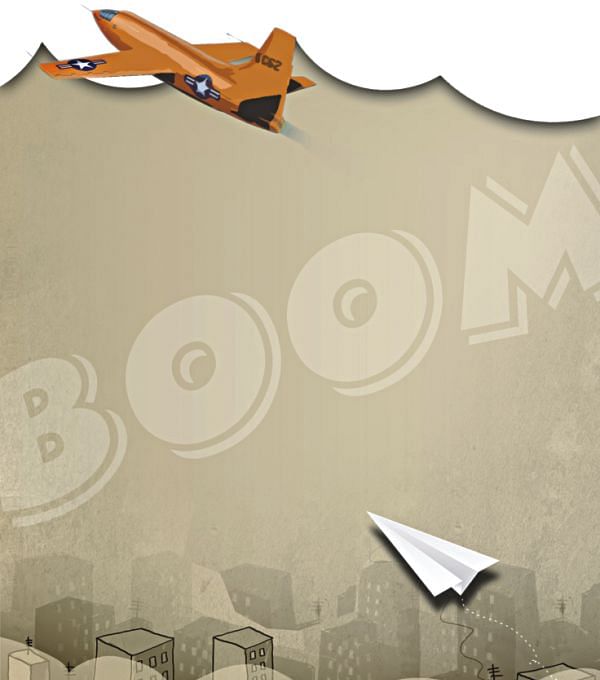The Supersonic Man

Story: Shaer Reaz
Cover art: E R Ronny
Man has always had an obsession with speed. It's a powerful thing. Entire generations are affected with this disease, a… uhm… desire. A need for speed. Yes.
Now that the annoying cliché's been used and accounted for, we can move on. Speed actually is quite an incredible thing. Throughout the 20th and 21st centuries, more world records have been broken, made or renewed in the category of speed than any other. Humans have been relentless in the pursuit of breaking some speed record or the other. Take for example the Ferrari F40: a sublime and simply marvellous, indomitable piece of engineering from the characteristically lethargic Italians; it was the first production car to break the 200 miles per hour barrier, in 1986, guaranteeing its spot on the bedroom walls of hormonal teenagers. Now, a mere 26 years later, mechanical engineering has progressed to the point where the fastest car in the world can reach speeds of 260 mph and it only takes less than 2.5 seconds to reach 60 mph (100 km/h).
Strange things happen at high speeds. Inside particle colliders, high speed collisions result in strange new particles that exist for microcosms of a second. A car barrelling down a road does so with mechanical motions that grind and grip in a sickeningly beautiful manner. Jet engines process billions of cubic centimetres of air every minute, compressing it, and then pushing it out in an effort to propel a plane and its passengers even faster.
The men and women who dare to venture into the murky, dangerous depths of speed and the outer reaches of high school physics, can be called nothing short of superheroes. These are the people who dared to ask questions like “how fast can we go?”
More often than not, fighter pilots have the answer. Fighter pilots have a special knack for surviving at high altitudes, insane speeds, all in the constant threat of a battle high up in the sky. Some are born with this survival instinct, some have it hammered into them during training. Once you've faced the enemy hurtling at you at speeds faster than a falling bowl of petunias, you can pretty much face anything. Paltry speed records are nothing in the face of a combat experienced pilot.
Meet Chuck Yeager.
*Deep Breath* He has a US Air Force Command Pilot Badge, an Air Force Distinguished Service Medal, a Silver Star, a Legion of Merit, a Distinguished Flying Cross, a Bronze Star Medal, a Purple Heart, an Air Medal, an Air Force Commendation Medal, a Presidential Unit Citation, an Air Force Outstanding Unit Award, an American Defense Service Medal, an American Campaign Medal, an European-African-Middle Eastern Campaign Medal, a World War II Victory Medal, and a Presidential Medal of Freedom. Oh, and just for breaking the sound barrier for the first time on October 14, 1947, he was awarded the Congressional Silver Medal in 1976.
The race to travel faster than sound began in a German lab deep in Nazi science experiment territory. At the time the Germans were winning the race of jet propulsion, and had a prototype jet fighter as early as 1939. With the first operational jet fighter, the Messerschmitt Me 262, the German Luftwaffe dominated Europe's air space, prompting a hurried response from the Allies when they finally realised the advantages of jet powered fighter aircraft.
Chuck Yeager joined the war as a private in the US Air Force, and quickly climbed the ranks to become a pilot, operating the legendary P-51 Mustang plane. He holds the record of the first kill of a German Messerschmitt thus marking the first time a propeller engine plane won out in a dog fight against a jet propelled one. He would survive the war as one of USAF's best flying aces.
After the war, Yeager turned to flight testing experimental planes for the air force. Because of his extraordinary track record in aerial combat, along with his incredible 20/10 vision, he was selected for the test flight of the Bell X-1. Apparently this was after another test pilot demanded $150,000 of “insurance”, because of the incredible risks involved in flying an aircraft which can theoretically break the speed of sound.
Developed by NACA (National Advisory Committee for Aeronautics, NASA's forefather) and the aircraft manufacturer Bell, the Bell X-1 was described as a “bullet with wings”, its shape considered to be ideal for supersonic (faster than sound) travel. It had almost no safety features, no ejection seat (because of its shape) and no way of bailing out for the pilot, if something were to go wrong. It was like being trapped in a giant aerodynamic barrel. Which flies. At speeds that creates sonic booms and would crush a regular plane like a paper model.
The X-1 was launched out of the bomb bay of a modified B-29 Superfortress bomber, because traditional takeoff and landing gear would have made a mess of the aerodynamics. Captain Charles “Chuck” Yeager flew the X-1 to a speed of Mach 1.06 (361 m/s, 1,299 km/h, 807.2 mph), successfully crossing the speed of sound, which is 330 m/s. He glided the X-1, christened the Glamorous Glennis after his wife, onto a dry lake, completing the first manned supersonic flight.
The impact of this one flight was massive. Jet and rocket propulsion became the staple of fighter aircraft, and passenger flights were never the same either. The Concorde happened, the first time a passenger aircraft flew at the speed of sound. Man on the moon happened. Space Shuttles happened, satellites happened, International Space Station happened. The world as we knew it changed. All because someone, somewhere, was brave enough to step into a flying bucket and fly at insane speeds.
The world salutes you, Chuck Yeager. Godspeed.
